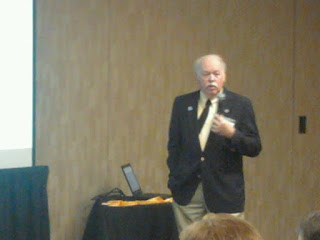Join us on the ACS Division of Small Chemical Businesses Program Track at the ACS National Meeting in New Orleans to hear @pidguy's *true story*
26 - Developing and marketing an environmental instrumentation company: A forty year perspective
Jack N. Driscoll, PID Analyzers, LLC, Sandwich, MA 02563, United States
HNU Systems, Inc., was founded by Driscoll & Spaziani in December 1973, intending to develop a new technology, photoionization detection (PID), for the analysis of environmental pollutants. We went to NIOSH in Cincinnati to explore potential uses of PID in industrial hygiene. During our visit, a scientist at NIOSH said, "If you had a portable instrument that would measure vinyl chloride monomer (VCM) at 1 ppm, we would be very interested." We went to a gas company the next day to get a lecture bottle of VCM and that afternoon we had a VCM monitor. A working prototype portable (battery operated) PID was built for the AIHCE show and, two months later, we got our first order from BFG. Once the evaluation period was over, we received an order for 50 units from BFG. In addition, BFG licensed their process for manufacturing VCM worldwide and included photoionization as the method of choice for VCM monitoring. We were off and running with VCM for the first few years. The next 35 years included rapid growth and then contraction as the economic times and markets changed. A number of years of economic struggles was followed by reorganizing and forming a new Company, PID Analyzers. Since bank financing has become more difficult in the past decade, PID has reverted to self funding to continue growing. These financial issues along with changing sources for parts will be discussed in detail.
Jack N. Driscoll, PID Analyzers, LLC, Sandwich, MA 02563, United States
HNU Systems, Inc., was founded by Driscoll & Spaziani in December 1973, intending to develop a new technology, photoionization detection (PID), for the analysis of environmental pollutants. We went to NIOSH in Cincinnati to explore potential uses of PID in industrial hygiene. During our visit, a scientist at NIOSH said, "If you had a portable instrument that would measure vinyl chloride monomer (VCM) at 1 ppm, we would be very interested." We went to a gas company the next day to get a lecture bottle of VCM and that afternoon we had a VCM monitor. A working prototype portable (battery operated) PID was built for the AIHCE show and, two months later, we got our first order from BFG. Once the evaluation period was over, we received an order for 50 units from BFG. In addition, BFG licensed their process for manufacturing VCM worldwide and included photoionization as the method of choice for VCM monitoring. We were off and running with VCM for the first few years. The next 35 years included rapid growth and then contraction as the economic times and markets changed. A number of years of economic struggles was followed by reorganizing and forming a new Company, PID Analyzers. Since bank financing has become more difficult in the past decade, PID has reverted to self funding to continue growing. These financial issues along with changing sources for parts will be discussed in detail.
Tuesday, April 9, 2013 11:15 AM
True Stories of Success from Chemical Entrepreneurs (08:00 AM - 11:50 AM)
Location: DoubleTree by Hilton New Orleans
Room: Crescent B
American Chemical Society members who were registered for the New Orleans Spring meeting can access the full presentation here with their ACS login. Otherwise ACS members and nonmembers can access this and all the Presentations on demand from #ACSNOLA with a paid subscription. See this link for pricing info.








